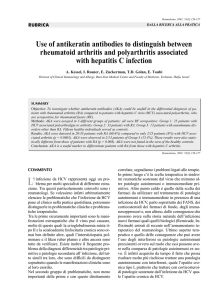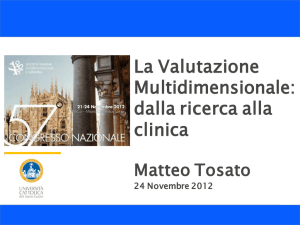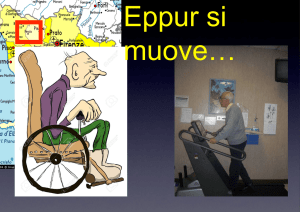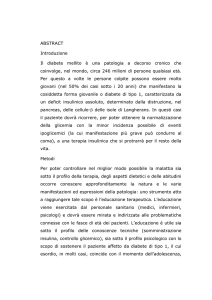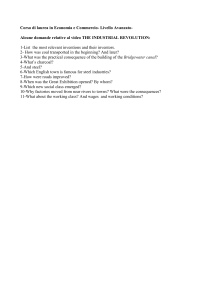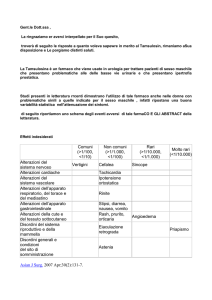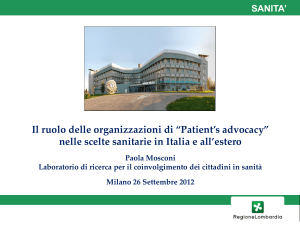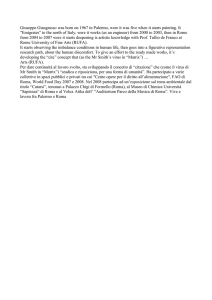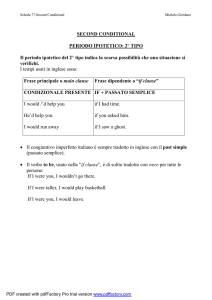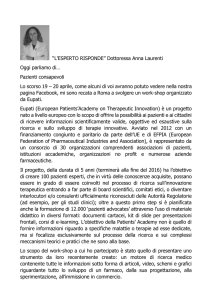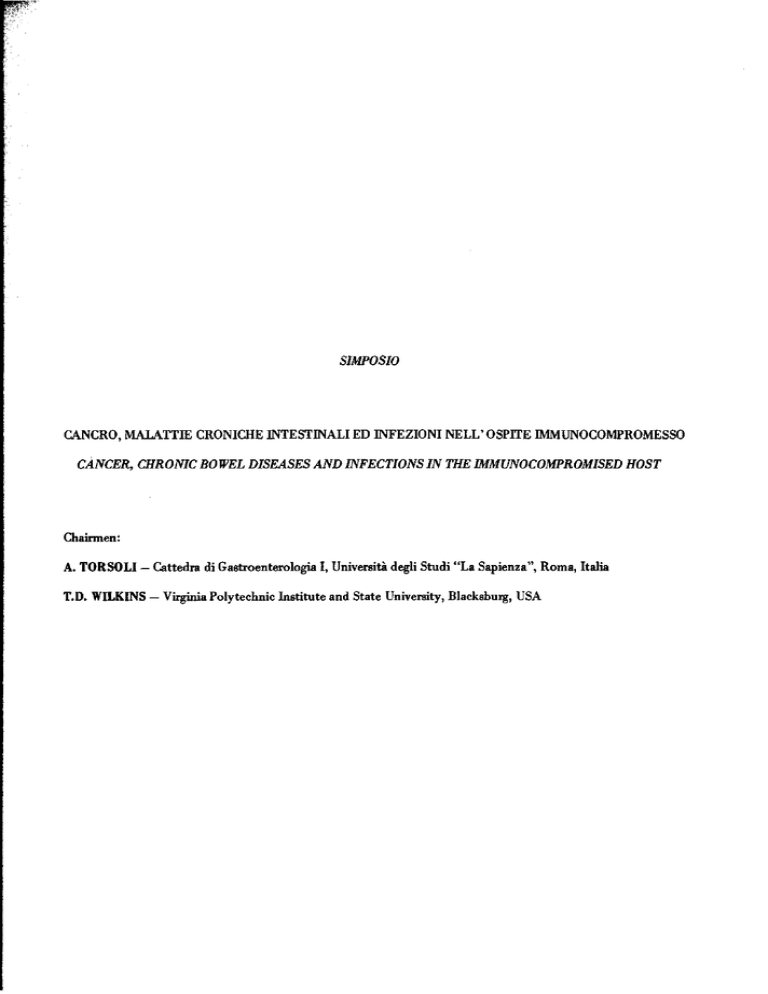
SIMPOSIO
CANCRO, MALATTIE CRONICHE INTESTINALI ED INFEZIONI NELL' OSPlTE IMMUNOCOMPROMESSO
CANCER, CHRONIC BO WEL DISEASES AND mTFECTIONS IN THE UMMUNOCOMPROMISEDHOST
Chairmen:
A. TORSOLI - Cattedra di Gastroentemlogia I, Università degli Studi "La Sapienza", Roma, Italia
T.D. WILKINS - Virginia Polytechnic hatitute and State Univeraity, Blacksburg, USA
Anrr II+ Supa. &n&ù
Vol. 22, N. 3 (1986). pp. 945-948
EPIDEMIOLOGY OF AN OUTBREAK OF CLOSTRIDIUM DIFFICILE-ASSOCIATED-DIARRHOEA.
APPLICATION OF A TYPING SYSTEM
S. Tabaqchali & S.R. Heard
Department of Medica1 Microbiology, St. Bartholomew's Hospital. London, UK
-
Summary.
A prospective epidemiological study of an outbreak of C.difficile
associated diarrhoea in an oncology ward is described. A typing scheme for
C.difficile based on polyacrylamide gel electrophoresis of 35S-methionine
labelled proteins was applied. The results demonstrated nosocomial acquisition
of C.difficile and that cross infection occurred among patients with a single
type X.
epidemic strain:
-
Riassunto (Studio su un episodio epidemico di diarrea associata al Clostridium
difficile. Applicazione di un sistema di tipizzazione). - Viene descritto uno
studio prospettico epidemiologico su un focolaio di diarree associate al C.difficile in una corsia oncologica. E' stato utilizzato uno schema di tipizzazione
basato sull'elettroforesi in gel di poliacrilamide di proteine marcate con
I risultati hanno dimostrato che l'acquisizione di C.difficile e
35~-metionina'
le infezioni crociate awengono con un solo ceppo epidemico: il tipo X.
Introduction
Antibiotic-associated diarrhoea and colitis (AAD and AAC) are part of the
spectrum of disease caused by the anaerobic gram positive rod, Clostridium
difficile. It is currently estimated that between 15-20% of al1 AAD is found in
conjunction with an isolate of the organism (1). Most cases of pseudomembranous
strains of
colitis (PMC) are currently believed to be caused bv toxiaenic
difficile (2).
The simole oresence of the ornanism in a faecal soecimen does not necessarily implicate it as a pathogen. It seems quite clear that other conditions
must pertain in the bowel in order to allow the organism to express its pathologica1 potential. Antibiotics and antineoplastic chemotherapy are amongst the
best documented precipitating factors, but iscahemia (3) and inflammatory bowel
disease ( 4 , 5 ) may, perhaps. also predispose to infection with the organism. An
understanding of the epidemiology of C.difficile has been hampered unti1
recently by the lack of a comprehensive typing scheme for the organism. Severa1
different approaches to the problem have now been considered. including phage
and bacteriocin typing ( 6 ) , immunoblotting (7). serotyping (8) and analysis of
the radiolabelled protein profile produced by the organism using SDS-PAGE (9).
We have developed the latter scheme into a simple. easily expandable system and
have described to date 9 standard strains of the organism (A-E. W-Z). Using
this typing method, we have prospectively studied a large outbreak of Clostridium difficile-associated-diarrhoea (CDAD) on male and female wards housing
both imunocompromised and genera1 medica1 patients.
Materials and Methods
Over a six-month period (May 1983-October 1983) the patients on the mixed
male and female oncology/medical wards were prospectively screened for the
presence of Clostridium difficile in faecal samples. The patients were housed
on a 25 bed open ward, with a centra1 partition separating the oncology and
genera1 medica1 patients. Toilet and bath facilities were shared, while the
nursing staff shared the care of both groups of patients. Medical staff tended
to look after only one group of patients.
An on-admission faecal specimen, taken within 48 hours of each patient's
arriva1 on the ward, was cultured on selective media (CCFA) under anaerobic
conditions for 48 hours. The organisms were identified by their macroscopic
morphology, appearance on gram stain. me11 and the ability to fluoresce under
ultraviolet light. Confirmation of their identify was achieved by gas liquid
chromatography in which the characteristic iso-caproic peak was seen. Additional samples were collected weekly for the duration of admission or more frequently if diarrhoea occurred, at which time examination for other enteric
pathogens was also undertaken.
Isolates of the organism were stored in Robertson's Cooked Meat Medium
(RCMM) unti1 required for typing. Organisms were typed according to the previously described method involving the incorporation of 35s-methionine into
bacterial proteins. Briefly, 2-3 colonies from a 48 hour anaerobic culture on
blood agar of each strain for typing were inoculated into 100 pC of 35s-methionine. After a 2 hour incubation under anaerobic conditions at 37'C.
an
equa1 volume of double strength electrophoresis buffer was added and the tubes
were boiled for 2 minutes. Electrophoresis on 12.5% polyacrylamide gels was
performed. followed by autoradiography.
Results
Table 1 shows the relevant screening data. 991 faecal specimens were
examined, from 249 patients. One hundred and thirtysix were oncology patients.
-
Table 1.
Screening data on oncology/medical wards for Clostridium difficile
(1.5.83 - 31.10.83)
Male
Female
Number of patients screened
249
136
113
Oncology patients screened
135
76
59
Medica1 patients screened
113
60
53
Total specimens examined
991
Number of patients positive
for Clostridium difficile
Number of oncolonv
-. ~atients
.
positive for Clostridium
difficile
Associated medica1 patients
positive for ~lostridium
difficile
62
(25%)
nnd 113 were general medical patients. Sixty-two patients (25%) in al1 had a
positive faecal culture for the organism. Forty-nine of the 136 oncology
patients (37%) were found to have C.difficile on faecal culture while 13 of the
113 (11.5%) medical patients carried the organism.
The typing results (Table 2) demonstrate that of the 49 oncology patients
found to carry the organism, 35 carried the epidemic strain, Type X, whilst the
remaining 14 patients carried a range of other strains (A, D, E, W, Y). Three
of the general medical patients had X strain, the rest again carrying a variety
of other strains.
Patients were also evaluated for acquisition of the organism during their
stay in hospital. Of the 49 oncology patients who were found to have the
organism, 12 were unevaluable since they were on the ward prior to the start of
the screen. Al1 of these patients carried the epidemic strain. Nine patients
were found to have the organism on the first specimen that was examined (within
48 hours of admission to the ward) and two of these were X strain. Twenty-eight
patients acquired the organism after being on the ward £or 48 hours or longer
and had had at least one faecal sample negative £or the organism. Twenty-two of
these patients acquired the epidemic strain, Type X. whilst the remaining si%
patients acquired other strains.
Discussion
The application of our typing scheme has helped to unravel some of the
previously unanswered questions regarding cross-infection and hospital acquisition of C.difficile. The results presented in this paper demonstrace £or the
first time that C.difficile is nosocomially acquired particularly among the
irmnunocompromised susceptible patients. This study also demonstratsd clearly
that cross-infection occurs in hospital wards and that it could become a
serious clinica1 problem.
Previous reports of clusters of cases (10) and outbreaks of PMC and AAC
were suggestive of nosocomial spread of C.dif£icile. particularly when the
organism was isolated from patients and their hospital environment, However,
the epidemiology of this organism had not been fully clarified in the absence
of a typing scheme. Severa1 workers have recently initiated various schemes to
investigate hospital outbreaks (6-9).
Although a number of different types of C.difficile were isolared on the
oncology ward, there was one strain, type X. which predominated. Thirty-five
out o£ the 49 oncology patients had type X. Of the 29 oncology patients who had
negative cultures within 48 hours of admission. 22 of those went on to acquire
type X. It appears therefore that type X is more virulent and spreads more
easily among patients that the other types which were isolated (A, D, W, Y).
The source of the outbreak is unclear, but it is possible that the 12
unevaluable patients who already had type X when the screening started, could
have provided the p001 £or type X.
Measures to contro1 the spread o£ the epidemic strain in the oncology ward
Table 2.
-
Types of Clostridium difficile isolated
Types of Clostridium difficile
A
B
Oncology patients
1
0
Associated medica1 patients*
1
3
*
C
0
D
1
0
one isolate died before typing could be performed.
E
5
1
W
1
3
X
3
0
Y
5
3
Z
6
0
1
0
were instituted by separating and isolating patients with C.difficile from
those who were not infected. These procedures were successful in limiting the
incidence of new cases (Heard et al., 1986, J. Infect. Dis.).
BARTLETT. J.G. h TAYLOR. N.S. 1982. Antibiotic-associated colitis. In:
Medica1 Microbiology. C.S.F. Easmon & J. Jeljaszewicz (Eds). Academic
Press, London. pp. 1-48.
BURDON, D.W., GEORGE. R.H., MOGG, G.A.G., ARABI. Y., THOMPSON. H., JOHNSON. M., ALEXANDER-WILLUMS, J. & KEIGHLEY. M.R.B. 1981. Faecal toxicity
and severity of antibiotic-associated pseudomembranous colitis. J. Clin.
Path. 34: 548-551.
WU. A. 1982. Spontaneous persistent pseudomembranous colitis related t0
Clostridium difficile in ischaemic bowel disease. B.M.J. 284.
BOLTON. R.P., SHERIFF. R.J. & READ, A.E. 1980. Clostridium difficile
associated diarrhoea: a role in inflammatory bowel disease? Lancet 1:
383-384.
LAMONT, J.T. & TRNKA, Y.M. 1980. Therapeutic implications of Clostridium
difficile toxin during relapse of chronic inflammatory bowel disease.
Lancet 1: 381-382.
SELL, T.L., SCAABERG, D.R. & FEXETY. F.R. 1983. Bacteriophage and bacteriocin typing scheme for Clostridium difficile. J. Clin. Microbiol. 17:
1148-1152.
POXTON, I.R., ARONSSON. B., MOLLBY, R., NORD. C.E. 6 COLLEE, J.G. 1984.
I~nochemicalfinger-printing of Clostridium difficile strains isolated
from an outbreak of antibiotic-associated-colitis and diarrhoea. J. Med.
Microbiol. 17: 317-342.
DELMEE, M.. HOMEL, M. & WAUTERS, G. 1985. Serogrouping of Clostridium
23-327..
difficile
- strains by slide sgglutination. J. Clin. Microbiol. 21: 3:-SILMAN. R. 1984. Typing
LI. S., O'FARRELL. S.. HOLLAND,
scheb for Clostridium difficile. Its application in clinica1 and epidemiological studies. Lancet 1: 935-938.
KABINS, S.A. & SPIRA, T.J. 1975. Outbreak of clindamycin-associated colitis. Ann. Intern. Med. 83: 830-831.
-
n
Ann I*. S u p . %&
Vol. 22. N. 3 (1986). pp. 949.952
FLORA BATTERICA INTESTINALE E TUMORI DEL COLON: ESCREZIONE E DEGRADAZIONE
INTESTINALI DEGLI STEROIDI NEUTRI IN SOGGETTI A RISCHIO PER CANCRO DEL COLON
L. Roncucci (a),
P. Di Donato (a), P. Rebecchi (a).
Carriero (b). N. Carulli (a) & M. Ponz de Leon (a).
C. Sacchetti (a),
A.
(a) Istituto di Patologia Medica. Policlinico Universitario, Modena;
(b) Istituto di Patologia Chirurgica, Policlinico Universitario, Modena, Italia
-
La flora batterica intestinale è in grado di metabolizzare gli
Riassunto.
steroli neutri e acidi in prodotti secondari. Con il nostro studio abbiamo
voluto valutare l'escrezione giornaliera degli steroli neutri e la degradazione
intestinale del colesterolo a prodotti secondari in soggetti a rischio di
cancro colorettale suddivisi in 4 gruppi più 1 di controllo. Campioni di feci
venivano raccolti per 3-6 giorni ed i singoli steroli analizzati mediante
gas-cromatografia. L'escrezione totale degli steroli neutri non è risultata
significativamente diversa tra controlli e i gruppi studiati. In tutti i
controlli il colesterolo era ampiamente convertito nei suoi metaboliti. mentre
negli altri gruppi alcuni soggetti convertivano poco il colesterolo: questo è
dovuto forse ad alterazioni della flora batterica intestinale.
Summary (Intestinal bacterial flora and colon cancer: excretion and degradation
The intestinal microflora is able to metabolize the
of neutral steroids).
neutral steroids and acids into secondary products. We studied the daily
excretion of neutral steroids and the intestinal degradation of cholesterol in
4 groups of high risk subjects for colon-rectal cancer and 1 control group. The
total excretion of neutral sterols was not significatively different between
the studied groups and controls. The cholesterol was highly degradated in the
control group, while in the other 4 groups some individuals were able to
metabolize it scarcely: this was probably due to alterations of the intestinal
microflora.
-
Introduzione
I1 cancro del grosso intestino è molto più frequente nei paesi ad elevato
sviluppo tecnologico. che in quelli meno industrializzati, dove la popolazione
consuma. in media, meno carne e grassi animali e più fibre vegetali (1-3).
Infatti, studi epidemiologici hanno mostrato una relazione fra consumo di carne
e grassi animali e incidenza di cancro color'ettale (4).
Nel 1971 Hill e Coll. riferirono che le popolazioni occidentali eliminavano con le feci elevate concentrazioni di acidi biliari e steroli neutri rispetto alle popolazioni africane e dell'estremo oriente ( 5 ) . In seguito lo stesso
gruppo riportò che pazienti con cancro colorettale eliminavano con le feci
maggiori quantità di acidi biliari rispetto ai controlli (6). Gli autori
ipotizzarono che il cancro colorettale fosse in qualche modo correlato alle
alte concentrazioni di prodotti secondari legati all'attività batterica intestinale, sia sugli steroli acidi. sia sui neutri (6, 7).
In seguito sono stati riportati risultati contrastanti su questo argomento.- ~robabilmente
a causa del numero relativamente ~iccolodi soeeetti studiati
e della frequente mancanza di controllo metabolico.
--
Gli scopi del nostro studio sono stati quelli di caratterizzare l'escrezione e la degradazione del colesterolo in prodotti secondari in soggetti senza
patologie gravi, mantenuti sotto controllo metabolico. e di paragonare questi
dati con quelli ottenuti da pazienti con polipi e cancro del grosso intestino.
Materiali e Metodi
Abbiamo studiato i seguenti gruppi: 38 individui senza gravi malattie
(gruppo di controllo); 22 pazienti con cancro colorettale (prima dell'intervento); 15 membri di 2 famiglie con alta prevalenza di polipi multipli del colon
(fra 3 e 10 polipi) e cancro del colon; 12 soggetti con polipi solitari senza
familiarità; 16 membri 4 dei quali affetti e 12 loro parenti di primo grado di
6 famiglie con poliposi familiare del colon, malattia ereditaria trasmessa di
generazione in generazione in modo autosomico dominante (8).
I soggetti studiati erano tenuti a dieta standard, contenente quantità
note di calorie e colesterolo (400 mg) al giorno. Ai soggetti venivano somministrate dosi giornaliere di
sitosterolo radioattivo e di Cr203 come "markers"
di recupero e di flusso fecale. Tutti i campioni di feci venivano raccolti per
almeno 3 giorni ed ognuno di essi analizzato separatamente. I singoli steroli
erano isolati mediante TLC e GLC, come precedentemente descritto (9.10). usando
5 d colestano come standard interno. In tal modo il colesterolo ed i suoi
principali metaboliti intestinali
coprostanolo e coprostanone - venivano
dosati ed analizzati separatamente.
-
Risultati
L'escrezione media totale giornaliera di steroli neutri nei 5 gruppi
studiati è mostrata nella Tab. 1. Abbiamo osservato un'ampia variazione dei
valori all'interno di ciascun gruppo con un range compreso fra 200 e 700
mgldie. In ciascuno dei gruppi studiati la differenza dai controlli era statisticamente significativa.
In tutti i gruppi studiati il coprostanolo era lo sterolo più abbondante.
compreso fra 50 e 98% del totale: conseguentemente la somma dei 2 metaboliti
intestinali. coprostanolo e coprostanone. rappresentava la quota maggiore di
steroli neutri escreti. I1 "pattern" di degradazione mostrava solo modeste
fluttuazioni durante i 3 giorni di raccolta.
All'interno di ognuno dei 3 gruppi di pazienti con polipi e del gruppo di
pazienti con cancro colorettale si potevano identificare 2 distinte popolazioni, una con un tipo di degradazione simile a quello dei controlli (Alti Convertitori conversione alta o quasi completa del colesterolo nei prodotti secondari). l'altra (Bassi Convertitori) con una conversione del colesterolo scarsa o
assente.
Tabella 1. - Escrezione degli steroli neutri totali nei 5 gruppi studiati
(media + ES)
-
N
Controlli (38)
Cancro colorettale
Polipi solitari
Polipi multipli
Poliposi familiare
mg/die
range
Lo stato di basso convertitore è stato osservato in 6 pazienti su 22 con
cancro colorettale, in 5 su 16 membri delle famiglie con poliposi familiare. in
4 soggetti su 12 con polipi solitari, e in 2 su 15 membri di famiglie con
polipi multipli. La differenza coi controlli raggiungeva la significatività
statistica (p < 0,Ol) solo nel gruppo della poliposi familiare.
Discussione
I nostri risultati indicano che non esiste una differenza significativa
nell'escfezione degli steroli neutri totali fra controlli e pazienti a rischio
di cancro colorettale. Tuttavia, in una minoranza dei pazienti. il colesterolo
è scarsamente degradato in coprostanolo e coprostanone. Livelli di steroli
neutri fecali superiori ai controlli sono stati osservati in diversi gruppi di
pazienti ad aumentato rischio di cancro colorettale, come nel caso della
poliposi familiare, della sindrome di Gardner e della colite ulcerosa (11). In
questi studi. tuttavia, per lo più condotti senza controllo metabolico, il
parametro studiato era la concentrazione di steroli fecali (mglg di feci secco)
e non la escrezione giornaliera.
Sebbene la maggior parte dei pazienti con cancro colorettale e polipi
sembri convertire il colesterolo nei suoi metaboliti. in una minoranza di essi
il colesterolo non veniva praticamente degradato. Risultati simili erano già
stati riportati in precedenza in pazienti con poliposi familiare, cancro del
colon familiare e nei loro parenti di primo grado (8-13). I1 nostro studio
estende queste osservazioni ad altri gruppi di pazienti con neoplasie del
grosso intestino senza una chiara familiarità.
In conclusione, ci sembra che le informazioni disponibili siano ancora
insufficienti per chiarire se gli steroli neutri fecali siano correlati al
cancro colorettale. e se la definizione della escrezione e della degradazione
degli steroli neutri possa essere utile nell'identificazione di individui a
rischio.
In particolare occorrono ulteriori studi longitudinali per accertare se lo
stato di basso convertitore aumenti la suscettibilità al cancro colorettale e
possa quindi permettere la sorveglianza nel tempo di soggetti a rischio.
BIBLIOGRAFIA
WYNDER. E.L. 1975. The epidemiology of large bowel cancer. Cancer Res. 35:
3388-3396.
...- .- . . .
WYNDER, E.L. & REDDY, B.S. 1973. Studies of large bowel cancer: human
leads to experimental application. J. Natl. Cancer Inst. 50: 1099-1106.
I.A.R.C. Group 1977. Dietary fibre, transit time. faecal bacteria, steroids and colon cancer in two Scandinavian populations. Lancet 2: 207-211.
KAY, R.M. 1981. Effect of diet on the fecal excretion and bacterial
modification of acidic and neutra1 steroids, and implication for colon
csrcinogenesis. Cancer Res. 41: 3774-3777.
H I U , M.J., CROWTHER, J.S., DRASAR, B.S., et al. 1971. Bacteria and aetiology o£ cancer of large bowel. Lancet 1: 536-539.
HILL, M.J., DRASAR, B.S., WILLIAMS, R.E.O.,
1975. Faecal bile acids
and clostridia in patients with cancer o£ the large bowel. Lancet 1:
536-519.
- - - --- .
HILL. M.J. 1981. Diet and the human bacterial flora. Cancer Res. 41:
3778-3780.
LIPKIN, M., REDDY, B.S., WEISBURGER, J. et al. 1981. Nondegradation of the
fecal cholesterol in subjects at high risk for cancer of the large intestine. J. Clin. Invest. 67: 304-307.
e.
9. MIETTINEN. T.A., AHRENS, E.H. & GRUNDY, S.M. 1965. Quantitative isolation
and GLC analysis of total dietary and fecal neutral steroids. J. Lipid
Res. 6: 411-424.
10. McNAMARA. DJ.. PROIA, A. & MIETTINEN, T.A. 1981. TLC and GLC identification of neutral steroids in human and rat feces. J. Lipid Res. 22:
474-484.
11. CRUSE. P., LEWIN, M. & CLARK, C.G. 1979. Dietary cholesterol is co-carcinogenic for human colon cancer. Lancet 1: 752-755.
12. WILKINS, T.D. & HACKMAN, A.S. 1974. Two patterns of neutral steroids
conversion in the feces of norma1 North Americans. Cancer Res. 34:
2250-2254.
13. WATNE, A.L.. LAI, H.Y., MANCE, T. et al. 1976. Fecal steroids and bacterial flora in patients with polyposis coli. Am. J. Surg. 131: 42-46.
-
Ann Iis. Super. &n&
Voi. 22, N. 3 (1986). pp. 953-958
PAECAL CARRIAGE OF CLOSTRIDIUM DIFFICILE IN CYSTIC FIBROSIS PATIENTS
$.L. Peach (a), H. Gaya (a) & S.P. Borriello (b)
(a) The London Chest Hospital, London;
(b) The Clinica1 Research Centre, Harrow. England
Summary. - Faecal samples from 37 patients with cystic fibrosiis (CF) and 40
contro1 patients have been examined for the presencé of Clostridium difficile.
Overall the isolation rate of this organism from control subjects was similar
to that described in other published works. Rowever, there was a high isolation
rate (overall, 29.7%) from patients with CF. Many of the isolates could be
shown to produce cytotoxin in vitro, and cytotoxin was detected in some of the
~toolsamples. Despite this, C.difficile appeared to be carried asymptomatically by the patients in this study.
Riassunto (Presenza di C.difficile nelle feci di pazienti affetti da fibrosi
cistica). - Sono stati esaminati per la presenza di C.difficile campioni fecali
di 37 pazienti con fibrosi cistica (CF) e 40 pazienti controllo. Mentre la
percentuale di isolamento nei controlli è risultata simile a quella riportata
in altri lavori, quella relativa ai pazienti con CF è risultata più elevata
(29.7%). Molti dei ceppi isolati erano tossigenici in vitro e la citotossina è
stata rilevata anche in alcuni campioni fecali, ma ciò nonostante il C.difficile sembra colonizzare questi pazienti senza produrre malattia.
Introduction
Cystic fibrosis is the most common lethal genetic syndrome among white
children and is the cause of much of the chronic progressive pulmonary disease
encountered in children.
It is an autosomal recessive disorder characterised by high sodium chloride content in sweat, pancreatic insufficiency (and consequent malabsorption)
and hypertrophy of the mucus secreting glands. This latter symptom makes the
lungs very susceptible to infection and pulmonary disease accounts for more
than 95% of deaths of patients with cystic fibrosis (CF). Because of this.
these patients receive almost continua1 antimicrobial prophylaxis. They would
thus appear to be prime candidated for gastrointestinal colonisation with
C.difficile, although symptoms of antibiotic associated enteric disease are
rare. Wu et al. (1) noted a 50% carriage rate of C.difficile, but most of the
isolates did not produce cytotoxin.
The present study was undertaken for 3 reasons. Firstly, to establish the
norma1 carriage rate of C.difficile in the stools of patients of the Brompton
Hospital Group, London, (Brompton Hospital and London Chest Hospital), secondly
to establish the carriage rate of this organism in CF patients and thirdly to
find the incidente of toxigenic strains of C.difficile in these patient groups.
Materials and Methods
-
There were 40 control patients (35 London Chest Hospital, 5
Patients.
Brompton Hospital) with a range in age of 56 years (range 27-78 years). Twelve
control patients were receiving antibiotics. The control patients were suffering from respiratory tract other than CF. This included emphysema, asthma.
chronlc obstructive airway disease and carcinoma.
The 37 CF patients (8 London Chest Hospital, 29 Brompton Hospital) had a
mean age of 19 years (range 6-32 years) and al1 but two were receiving antibiotics. Most of these patients were also being treated for pancreatic insufficiency which was well controlled.
None of the patients (controls or CF) had diarrhoea at the time of the
study.
About 10 g sto01 sample were sent to the laboratory
Faecal samples.
directly or by post. They were stored untreated at -20°C for up to one month.
Bacteriological investigations. - Approximately 0.1 g were seeded onto a
prereduced selective medium (CCA) containing D-cycloserine (500 &L)
and
Cefowitin (20 mg/L) (2). Seeded plates were incubated for 48 hours at 37'C in
anaerobic jars. Anaerobiosis was achieved with the use of the 'Gas-kit' system
and palladium catalyst (Oxoid Ltd., Basingstoke, England).
A similar (0.1 g) sample was inoculated into Robertson's Cooked Meat
Medium RCM) and incubated aerobically at 37'C for 48 hours and then subcultured
onto CCA. After incubation the primary CCA plates were examined for typical
C.difficile colonies. A semi quantitative estimate of the amount of growth was
growth in the 'pool' area only. ft
growth in p001 and primary
scored: +
streaks, ++t growth in p001 and in primary and secondary streaks. When
+ for
C.difficile was recovered only from the RCM that faecal sample was scored the organism.
Identification of C.difficile isolates. - Initial identification of
isolates was by characteristic colonia1 morphology, smell (paracreosol),
typical Gram reaction and the ability of the colonies to show characteristic
fluorescence under 360 nm ultra-violet light. Identification was conflrmed by
conventional techniques, including gas-liquid chromatography.
Tests for cytotoxin activity. - Isolates were tested for their ability to
produce cytotoxin acting against vero cells as described by Larson and Price
(3). The neutralizing agent was C.sordellii antitoxin (Wellcome Research
Laboratories, Kent, England). One in ten dilutions of stools that were positive
for C.difficile were also tested for the presence of cytotoxin.
-
-
-
E
Results
Isolation of C.difficile from control patients. - C.difficile was isolated
from two of the twelve control patients who had received antibiotics - an
isolation rate of 16.6% (Table 1). These patients had been treated with cephalosporins (Table 2).
Table 1.
-
Isolation of C.difficile (CD)
- from contro1 patients
Treatment
No. tested
Antibiotics
No antibiotics
Total
28
40
-
No. CD positive
90 Isolation rate
- Contro1 patients carrying C.difficile (CD)
-
Tnble 2.
Ape
Sex
CD
isoxted
Cytotoxin
in culture
Il
F
+
+
64
M
+
-
Cytotoxin
in sto01
Diagnosis
Antibiotic
+
Ca lung
-
Bronchiectasis
Ceftazadirne
Ca lung
Cefuroxime
-
(Steroid)
The organism was isolated from only one of the twenty-eight control
patients who had no antibiotic treatment (3.5%) (Table 1 ) . In total, therefore.
7.5% of the control patients were found to be carrying C.difficile in their
stools. Two of these isolates produced cytotoxin in vitro. Cytotoxin activity
could also be detected in the stools of one of the control patients carrying
C.difficile (Table 2).
Isolation of C.difficile from patients with cystic fibrosis.
Overall.
eleven of the CF patients (29.7%) carried C.difficile in their stools (Table
3 ) . There was a marked differente in the isolation rate of the ornanism from
patients at the London Chest Hospital (50%) compared with those at the Brompton
Hospital (24%). However, two of the Brompton patients had not received antibiotics and a further seven had received local. nebulized antibiotics. C.difficile
was not isolated from them. If these patients are discounted from the total,
the isolation rate for this hospital rises to 35%.
Al1 of the CF patients from whom C.difficile was isolated had been treated
systemically with a p-lactam antibiotic (Table 4). In addition, many had
received an aminoglycoside.
Six isolates from CF patients could be shown to be capable of producing
cytotoxin in vitro (Table 4). Cytotoxin was also detected in the stools of
three patients.
-
P
iscussion
i
Bearing in mind the small number of patients investigated in the
tudy. the overall carriage rates of C.difficile in the stools of the
roup of patients are similar to those described elsewhere. A carriage
3% has been noted amongst norma1 healthy adulta ( 4 - 6 ) and 21%
dults receiving antibiotics who had no diarrhoea or pseudomembranous
6)
-
Cable 3.
-ospita1
*
- Isolation of
No. tested
C.difficile
(2)from cystic
No. receiving
antibiotics
fibrosis patients
No. CD
positze
7 patients received only nebulized antibiotics.
present
control
rate of
amongst
colitis
X Isolation rate
REFERENCES
WU,T.C., McCARTHY. V.P. & GILL. V.J. 1983. Isolation rates and toxinenic
potential of Clostridium difficile isolates from patients with cistic
fibrosis. J. Infect. Dis. 148: 176.
GEORGE. W.L., SUTTER, V.L., CITRON, D. & FINEGOLD. S.M. 1979. Celective
and differential medium for isolation of Clostridium difficile. J. Clin.
Microbiol. 9: 241.
LARSON, H.E. h PRICE, A.B. 1977. Pseudomembranous colitis: vresence of a
clostridial toxin. Lancet 11: 1312.
FEKETY, R., SILVA, J. Jr., TOXHNIWAL. R., ALLO, M., ARMSTRONG, J., BROWE.
R.. EBRIGHT. J. & RIFKIN. G.D. 1979. Antibiotic-associated colitis:
.--.-effects of intibiotics on Clostridium difficile and the disease in hamsters. Rev. Infect. Dis. 1: 386.
LARSON. H.E., PRICE. A.B.. HONOUR. P. & BORRIELLO, S.P. 1978. Clostridium
difficile and the aetiology of pseudomembranous colitis. Lancet I: 1063.
VISCIDI, R., WILLEY, S. & BARTLETT, J.G. 1981. Isolation rates and toxigenic potential of Clostridium difficile isolates from various patiént
populations. Gastroenterology 81: 5 .
WILLEY. S.E. & BARTLETT, J.G. 1979. Cultures for Clostridium difficile in
stools containing a cytotoxin neutralised by Clostridium sordellii antitoxin. J. Clin. Microbiol. 10: 880.
BARTLETT. J.G., TAYLOR, N.U., CHANG, T.W. 6 DZINK, J.A. 1981. Clinica1 and
laboratory observations in Clostridium difficile colitis. Amer. J. Clin.
Nut. 33: 2521.
GEORGE, W.L., ROLFE, R.D. 6 FINEGOLD, S.M. 1982. Clostridium difficile and
its cytotoxin in faeces of patients with antimicrobial agent-associated
diarrhoea and miscellaneous conditions. J. Clin. Microbiol. 15: 1049.
GREWPIELD, C.. SZAWATBOWSKI, M., NOONE, T.. BURROUGIIS, A., BASS, N. &
POUNDER. R. 1981. Ig pseudomembranous colitis infectious? Lancet I: 371.
-
-
Ann iit Su*.
.%M
VoL 22. N. 3 (1986). pp. 959-964
SOME ASPECTS OF COLONIC MiCROBiAL ACTIVITY IN IRRITABLE BOWEL SYNDROME
ASSOCUTED WITH W O D INTOLERANCE
b
i
C.E. Bayliss (a). H.K.
Bradley (a). V. Alun Jones (b) & J.O. Hunter (b)
(a) AFRC Food Research Institute Nerwich, Colney Lane, Norwich;
(b) Addenbrookes Hospital. Hills Rd., Cambridge, UK
-
Summary.
Bacteriological studies on stools from patients three m n t h s posthysteroctomy showed that increased score of Irritable Bowel Syndrome (IBS)
symptoms was associated with significantly increased levels of aerobic bacteria, whereas in 'naturally arising' IBS patients levels of aerobes were similar
to those in contro1 subjects. There was a greater diversity of aerobic species
and decreased recovery of Gram positive aerobic bacteria in both groups of
patients. No significant differences were observed in moisture. pH or volatile
fatty acid content of faeces of patients and controls.
del colon nella sindrome del
Studi batteriologici
mostrano che un
sindrome dell'intestino irritabile (IBS) è associato
con IBS sorto
sono simili a
In entrambi i gruppi di pazienti c'è una
ed una diminuita frequenza di isolamento
state osservate differenze significaacidi grassi volatili contenuti
elle feci di pazienti e controlli.
-
Food intolerance 1s a major factor of Irritable Bowel Syndrome (IBS) and
association between food and symptoms has been tested (1). Severa1 observaons point to the significancs of the bacterial flora in this phenomenon. In
ny patients symptoms start after a gut infection or date from courses of
tibiotics or from abdominal or pelvic surgery (2). Food challenge in these
ients does not produce symptoms of pain, flautance and sometimes diarrhoea
il 16-72h after challenge and there is little, if any, evidence of any
unological abnormality (1).
In some patients pilot studies have indicated higher aerobic bacterial
unts in faeces of IBS patients than in controls. A more diverse range of Gram
gative aerobic bacteria was isolated from patients (3).
In this study levels of aerobic bacteria, moisture content, pH and volatifatty acids (VFA) were determined on 103 sto01 samples from 101 subjects.
subjects were a group of patients from a double blind, controlled, prospechysterectomy atudy which showed that treatment courses of antibiotica
eased the vulnerability of patients to IBS (4). and 'naturally arising' IBS
erers presenting at clinic, prior to exclusion diet therapy, together with
a control group.
Materials and Methods
Freshly passed stools were collected at home to minimise stress and
transported under cool conditions to the laboratory for analysis within 5 hrs.
Aerobic bacteria were enumerated using CLED (Oxoid) agar. moisture content was
measured by drying samples (c.5g) to constant weight at 100eC and VFA vere
estimated by headspace analysis. Aerobic bacteria were characterised using the
API 20E identification system (API Laboratory Products) or the methods of Cowan
(5). Data from samples which were delayed in transit, or where patients were
subsequently found to have clinically defined diseases, was discarded. IBS
symptom scores in hysterectomy patients were assessed using questionnaires
preoperatively and 3 and 18 months post-operatively.
Results
The viable aerobic bacterial counts in faeces were similar for both IBS
and control categories (Table 1). Analysis of the data relating to the 'naturally arising' IBS group also showed that counts were not significantly different from the control group.
Table 1.
- Faecal properties in food related IBS
N
Log10 aerobic Moisture
bacteria/g
content (%)
wet weight
N
PH
Mean
SE
Mean
SE
Mean
SE
56
35
7.62
7.47
0.14
0.16
75.0
72.2
1.0
1.0
7.10
7.10
0.08
0.08
'Naturally arising'
IBS
38
Contro1
16
7.65
7.42
0.14
0.17
74.4
73.8
1.2
1.5
7.09
7.01
0.10
0.14
3-months posthysterectomy
Placebo only
5
7.04~ 0.32
Prophylaxis
1O
6.80~ 0.47
Antibiotic
treatment
18
7 . ~ 2 ~0.16
Al1
categories
IBS
Contro1
Total VFA
moles/g
wet weight
Mean
SE
38
34
118
112
6
5
26
16
125
115
7
8
a
Coefficient of contrast p-0.018
(Placebo only and Prophylaxis vs. Antibiotic Treatment)
N No. of samples tested
-
Assessment of the symptoms related to IBS in gynaecology patients using
questionnaires showed that there was a significantly greater increase in
rymptom score in patients who had received post-operative treatment courses of
intibiotico than those receiving placebo or Metronidazole prophylaxis (p-<0.04)
(4). and furtherinore that stools fron these patients showed higher viable
counts of aerobes (Table 1). There was a significant correlation betveen
h o n t h s pose-operative symptorn score and aerobic bacterial count irrespective
drug treatment (Fig. 1).
There were no significant differences in moisture content, pK and VFA
Levels (Table 1) or proportions of individua1 acids (data not shown) for al1
:ategories tested*
Escherichia tlnd Streptococcus were the c o m o n genera in the stools. Other
genera isolated were Staph~lococcus, Proteus, Klebsiella. Enterobacter and
licrococcus. Genera other than Escherichia and Streptococcus were isolated from
17 out of 38 patients f r w the 'naturally arising' IBS group and 4 out of 16
:ontrols, and from 5 out of 33 hysterectomy pafients if whom 4 had a high
iymptom score. There was a decrease in the X Gram positive aerobic bacteria in
:he stools in che patient groups (Table 2). although the decrease was not
lignificant.
i
P gure 1.
- Correlation
between 3-month post-operative
aerobic sto01 count.
symptom score and
Table 2.
- Gram positive aerobic bacteria present in faeces
N
Mean %
S.E.
IBS
CON
55
34
30.2
34.5
5.0
6.7
0.61
IBS
CON
42
19
36.5
45.3
6.1
9.1
0.42
Treatment
P
Al1 categorie8
'Naturally arising'
3-month post-hysterectomy symptom score vs. species.
Placebo +
Prophylaxis
15
Antibiotic
treatment
16
22.0
8.5
Discussion
In this study we have shown that hysterectomy patients who exhibit IBS
symptoms post-su~gery excrete higher concentrations of aerobic bacteria in
faeces.
In healthy individuale transient increases in numbers of aerobes and the
appearance of Klbbsiella, Enterobacter and-Serratia are known to occur followiag treatment wilth Metronidaeole (6). In the hysterectomy patients from the
study reported here sto01 samples were taken severa1 weeks after antibiotic
treatment suggesging either that antibiotic treatment per se was not significant or that in patients suffering from IBS symptoms the changes in flora
resulting from antibiotic treatment were less easily reversed. The trend
towards decreased numbers of Gram ,positive aerobes and the appearance of
organism other than
and streptococci in both groups was not statistically significant~,but it is possible that within the limited number of individuale tested mone than one microbiologically distinct group existed. These
groups are different to those observed by Balsari et al. (7) who showed that
with a group of IBS patients whose altered intestinal mobility was described as
being 'essentially caused by psycho-functional phenomena' faecal c o l i f o m were
significantly reduced. These authors also reported the appearance of Pseudomonas and Enterobapter although it is not clear whether these organisms were
associated with hbspitalisation, The changes in the flora in the limited number
of out-patients dtudied here supports the idea that in some IBS patients the
state of the aezobic gut flora may be an indicator of the disease state,
although further work would be required to elucidate the significante of these
changes.
There was no significant difference between patients and controls in
faecal miosture, pR or VFA content. Many patients with IBS show symptoms of
diarrhoea but thd difference in moieture content between formed and unformed
stools can be as low as 1-2% (C.E. Bayliss: unpublished data).
This work was supported by a research grant from the East Anglian Regional
Health Authority. The authors wish to thank Alison Wilson, G.P. Evans, Nikki
Horn and G.M. Wyatt for their assistance with this study.
ALUN JONES. V,, MCLAUGHLAN, P.. SHORTHOUSE, M., WORKPUN, E. 6 WNTER. J.O.
1982. Food iqtolerance: a major factor in the pathogenesis of Irritable
Bowel Syndr*.
Lancet 8308: 1115-1117.
ALUN JONES. VI. HUNTER, J.O. 6 ROBINSON. R.E. 1984. The aetiological role
of antibiotic prophylaxis vith hysterectomy in Irritable Bowel Syndrome.
J. Obstet. Gyriaecol. 5 (Suppl.1): 522-523.
BAYLISS, C.E. 1 HOUSTON, A.P., ALUN JONES, V., HISHON, S. h HUNTW, J.O.
1984. Microbiblogical studies on food intolerance. Proc. Nutr. Soc. 43:
16A.
ALUN JONES, V,. BAYLISS. C.E., 6 BUNTER, J.O. 1985. Pathogenesis of
Irritable Bo-1
Syndrome: Roles of surgery and antibiotics. Medica1
Reaearch Socieity Abstracts, accepted.
v
a
n
d Steel's manual for the identification of
medica1 bactee$a. 2nd edition. Cambridge University Press.
LeVIS. R.P..
WIDEMILN. P.. SUTTER. V.L. 6 FINEGOLD. S.M. 1977. The effect
of me&oni&zdle
on h-n
faecal flora. In: ~etro&dazole. S.M. Finegold
(Ed.). Excerptb Medica, eterdam. pp. 307-319.
BALSARI. A.. (IECCAREUI, A., DUBINI, F.. PESCE, E. 6 POLI, G. 1982. The
feeal microbiall population in the Irritable Boitel Syndrome. Microbiologica 5: 185-194.
-
Ann In Super. Lhnitd
Voi. 22, N. 3 (1986). pp. 965-968
TUE MICROBIOLOGY OF ILEAL RESERVOIRS FOLLOWING RESTORATIVE PROCTOCOLECTOMY
M. Wilks (a), M. Pescatori (b), N. Shepherd
(C).
R.J.
Nicholls (b) & S. Tabaq-
chali (a)
(a) Department of Medical Microbiology. St. Bartholomew's Hospital h Medical
College. London;
(b) Department of Surgery, St. Mark's Hospital. London;
(C) Department of Histopathology, St. Bartholomew's Hospital & Medical College,
London, UK
Summary. - The bacteriology of ileal reservoirs in 66 patients is reported. The
mean total count was 7.2 log cfulg consisting of almost equa1 numbers of
1o
aerobes and anaerobes. A correlation was found between the counts of E.coli and
the degree of chronic inflammation in the reservoir. The possible significante
of this is discussed.
Riassunto (Studio microbiologico del serbatoio ileale in seguito ad intervento
di proctocolectomia).
Viene riportata la flora batterica presente in 66 pazienti con serbatoio ileale. La media della conta batterica era 7,2 log cfu/g
10
con un uguale numero di aerobi ed anaerobi. E' stata riscontrata una correlazione tra conte di E.coli e grado di infiammazione cronica nel serbatoio
ileale: ne viene discusso il possibile significato.
-
.
Patients with diffuse colonic diseases such as ulcerative colitis and
familial adenomatosis coli are successfully treated by proctocolectomy but at
the cost of a permanent ileostomy. As an alternative, colectomy and ileo-rectal
anastomosis to restore intestinal continuity has been widely used. However.
this has the disadvantage that not al1 the diseased tissue is removed, as the
rectum is preserved. Proctocolectomy maintaining the norma1 route of defaecaion by ileo-anal anastomosis avoids this disadvantage but function in these
atients. in particular frequency of defaecation, is often unsatisfactory.
The operation of restorative proctocolectomy with ileo-anal reservoir (1)
y overcome these problems. It appears to eradicate che disease but at the
me time restore gastrointestinal continuity and continence. The elimination
al1 the diseased tissue means that the risk to the patient of developing
rcinoma is also negligible. However, the operation leaves the patient with a
uch of small bowel in which faeces may remain for a considerable of time.
is could lead to a stagnant loop syndrome as a result of bacterial overgrowth
che reservoir due to stasis (2). Severa1 studies of the operation have now
en published but they have been concerned primarily with variations in operave technique and physiological studies of continence and evacuation (3). We
eviously reported a pathological and physiological assessment of 14 patients
o had this operation performed (1).
A more extensive pathophysiological assessment of 66 patients has now been
completed. In this paper we describe a possible correlation between the microbiologica1 findings and chronic inflammation of the pouch.
Materials and Methods
A specimen of pouch mucosa was obtained by sigmoidoscopy. Chronic inflammation was assessed microscopically using a numerica1 scale on the basi8 of the
degree of villous atrophy and the presence of a chronic inflammatory ce11
infiltrate consisting mainly of lymphocytes and plasma cells in the lamina
propria. Each parameter had a maximum score of 3 and the total maximum score
was therefore 6.
A second sigmoidoscopy was carried out to obtain a specimen for bacteriology. The specimen was placed in faecal transport broth (4) and frozen at -70°C
unti1 processed. Samples were thawed by placing in an anaerobic chamber. and
homogenised by the addition of glass beads and rotamixing for three minutes.
They were then serially diluted in the supernatant from pre-steamed Robertson's
Cooked Meat. For anaerobic incubation samples (100p1) were spread on the
surface of the following media which had been poured in the chamber: Brucella
blood agar and Kanamycin (50pg/ml)- Vancomyblood agar. neomycin (100pg/ml)
lysed blood agar were prepared by previously described methods
cin (5pgIml)
(5); Rogosa agar (Difco) with a fina1 pH of 5.4 as a selective medium for
lactobacilli. The dilution tubes were then removed from the chamber and 100ul
samples were spread on plates of the following media for ~ e r o b i ccultivation:
Blood agar, MacConkey agar. Anaerobic culture plates were incubated in the
chamber for up to 7 days at 35OC and the aerobic plates were incubated in the
in an atmosphere of air and 5% C02. Different
chamber for 2 to 3 days at 35'C
-
-
colony types were counted and subcultured onto fresh media for identification.
Counts were expressed as the logarithm of the number of colony-forming units
per gram (loglOcfu/g). The minimum number of bacteria that could be detected
was about 3.0 loglOcfu/g.
A possible correlation between the bacterial counts and the degree of
inflammation was assessed using the contingency coefficient, C (6).
Results
Al1 the specimens apart from one gave some bacterial growth (98%). The
mean total bacterial count was 7.2 log cfulg, consisting of almost equa1
10
numbers of aerobes (7.0 loglOcfu/g) and anaerobes (7.1 loglOcfu/g). Nearly al1
-.
-
the specimens grew aerobes (91%) but only 59% grew anaerobes.
There was some degree of chronic inflammation in nearly al1 the reservoirs.
Because there was no biochemical, haematological or physiological explanation for the inflammation, a possible correlation with the bacterial findings
was considered. It was found that there was a significant correlation between
the counts of Enterobacteriaceae. (consisting mainly of E.coli) and the degree
of chronic inflammation (p<O.001). Specimens with a count greater then 6.0
loglOcfu/g always had a high degree of chronic inflammation (Fig 1). In some
cases there was a high degree of inflammation but only a low count of Enterobacteriaceae.
O
1
2
3
4
5
6
CHRONIC INFLAMMATION
.-
Correlation between
chronic inflammation.
t
counts
of
Enterobacteriaceae
and
degree
of
iscussion
If 3 is responsible for the inflammation then this could be caused by
severa1 different mechanisms, e.g. production of toxins or other metabolic
products or it could be that the actual stains of E.coli are different in some
*ay, for example that they are invasive. The fact that high counts of E.coli
,ere invariably associated with inflammation makes the first suggestion the
lore likely. Finally, as inflammation makes the first suggestion the more
likely. Finally, as inflammation is also occasionally present in cases where
che bacterial counts were low, there may be other causes o£ inflammation.
REFERENCES
NICHOLLS. R.J., BELLIVEAU. P., NEIL, M., WILKS, M. & TABAQCHALI, S. 1981.
Restorative proctocolectomy with ileal reservoir construction: a pathophysiological assessment. Gut 22: 462-468.
TABAQCHALI, S. 1970. The pathophysiological role of small intestina1
bacterial flora. Scand. J. Gastroenterol. suppl 6: 139-163.
WILLIAMS, N.S. & JOHNSTON. D. 1985. The current status of mucosa1 proctectomy and ileo-mal anastomosis in the surgical treatment of ulcerative
colitis and adenomatous polyposis. Br. J. Surg. 72: 159-168.
CROWTHER, J.S. 1971. Transport and storapre of faeces for bacterioloprical
examination. J. Appl. ~acteiiol.34: 477-483.
WILKS. M.. THIN. R.N. & TABAOCHALI. S. 1984. Ouantitative bacteriolonv of
the vaginal floia in health aid diiease. J. ed. Microbiol. 18: 217-2s.
SIEGEL, S. 1956, Measures of correlation and their tests of significante.
In: Nonparametric statistics. McGraw Hill. New York. pp. 195-240.
Ann Lt S u p . Snad
Vol. 22, N. 3 (1986). pp. 969.972
LE COMPLICANZE INFETTIVE NEI PAZIENTI CON EMOPATIE MALIGNE
P. Martino (a), M. Venditti (a). C. Santini (a), A. Micozzi (a). G. Awisati
(b) & P. Serra (a)
(a) Semeiotica Medica 111"; (b) Cattedra di Ematologia. Università degli Studi
"La Sapienza". Roma, Italia
-
Riassunto.
Vennero studiate la frequenza, l'etiologia ed i1 tipo di infezioni
nei pazienti emopatici ricoverati negli anni 1982-84 presso la Cattedra di
Ematologia di Roma. 356 di 631 pazienti (56,4%) sottoposti a terapia citostatica svilupparono 504 episodi febbrili di provata o presunta infezione. Di
questi, ben 102 casi furono superinfezioni. Viene sottolineata l'emergenza dei
funghi e del C.difficile tra gli agenti di superinfezione.
Summary (Infections in patients with haematologic malignancies). - Frequence.
etiology and microbiological as well as clinica1 documentation of infections in
patients with hematological malignancies hospitalized at the Department of
Hematology of the University of Rome were studied over a span of three years
(1982-84). 356 out of 631 patients (56.4%) under cytotoxic therapy underwent
502 febrile episodes of proved or presumed infections. Out of these, 102
febrile episodes were superinfections. The authors underline the emergence of
fungi and Clostridium difficile as etiologic agents of superinfections.
[ntroduzione
La terapia antimicrobica empirica precoce con combinazioni antibiotiche
xesumibilmente sinergiche nei confronti dei più comuni agenti etiologici ha
:onsentito una notevole riduzione della mortalità Der com~licanzeinfettive nei
un grande contributo
azienti affetti da emopatie maligne (1). In par;icolar;
lla migliorata proposi dei pazienti granulocitopenici febbrili è stato dato
alle cefalosporine della terza generazione e dalle ureidopenicilline, particoarmente attive nelle infezioni dovute ai bacilli Gram-negativi. che sono stati
più frequenti agenti etiologici degli ultimi anni (2). Tuttavia nuovi patogei e cocchi Gram-positivi, la maggior parte dei quali resistenti ai trattamenti
opra menzionati, stanno emergendo (3). Lo scopo di questo studio retrospettivo
stato quello di valutare il tipo e la etiologia delle infezioni nei pazienti
mopatici ricoverati negli anni 1982, 83, 84 presso la Cattedra di Ematologia
ella Università di Roma.
tteriali e Metodi
i
Dal gennaio 1982 al dicembre 1984, 831 pazienti emopatici vennero ricover ti presso la Cattedra di Ematologia. Di questi 631 ricevettero chemioterapia
C tostatica per l'emopatia maligna di base. Al momento della febbre (T-38.5'C)
i pazienti furono subito valutati clinicamente e microbiologicamente e ricevett ro entro 2-4 ore combinazioni antibiotiche nelle modalità già descritte ( 4 ) .
Gli episodi febbrili iniziali furono classificati in accordo con De Jongh et
al. (5) come "infezioni microbiologicamente documentate" (sito ed etiologia di
infezione identificati). "infezioni clinicamente documentate" (sito di infezione identificato, non l'etiologia), "infezioni possibili" (segni e sintomi
equivoci di infezione), "infezioni dubbie" (retrospettivamente, la febbre fu
ritenuta di origine non infettiva). Allo stesso modo abbiamo distinto le
superinfezioni. vale a dire ogni infezione nello stesso sito iniziale causata
da una etiologia diversa da quella iniziale che si sia sviluppata durante la
terapia antibiotica o entro sette giorni dalla sua sospensione, o qualsiasi
infezione sviluppatasi in tale lasso di tempo in altre sedi. L'analisi statistica dei dati è stata eseguita attraverso la determinazione del chi-quadro.
-
Risultati
356 pazienti dei 631 emopatici trattati con chemioterapia svilupparono 504
episodi febbrili di probabile o provata infezione. Come mostra la Tabella 1
circa un quinto di essi furono superinfezioni.
Setticemie (170 casi) e polmoniti (65 casi) furono le principali cause di
morbilità, rappresentando insieme il 36.8% degli episodi febbrili iniziali e il
72.5% delle superinfezioni. 170/504 episodi febbrili furono associati a setticemia, nella maggior parte dei casi (119f170) il cui focolaio di origine non è
stato identificato. Come si vede nella Tabella 2, 172 patogeni responsabili di
infezione furono isolati inizialmante in 160 infezioni microbiologicamente
documentate.
Tabella 1. - Documentazione dell'infezione negli episodi febbrili iniziali e
nelle superinfezioni
Episodi febbrili
iniziali (402 casi)
n
(%l
Superinfezioni
(102 casi)
n
Infezioni documentate
microbiologicamente:
con batteriemia
senza batteriemia
Infezioni documentate
clinicamente:
Infezioni possibili:
Infezioni dubbie:
$ Sei casi di infezione doppia
§
Quattro casi di infezione doppia
-
Agenti etiologici delle infezioni isolati prima e dopo l'inizio
Tabella 2.
della terapia antibiotica
prima
Gram negativi
Gram positivi
Anaerobi
Funghi
dopo
9n
Bacilli Gram-negativi furono osservati nel 51,7% dei casi e microrganismi
m-positivi nel 38,9% dei casi, mentre funghi furono isolati nel 7,5% e
rorganismi anaerobi nellSl,7% dei casi. Fra tutti, E.coli fu la principale
ra di infezione iniziale (36/172), seguito da Staph.aureus (32/172) e da
(30/172). In aggiunta a questi agenti etiologici iniziae nei pazienti che svilupparono superinfezioni rivelarono
i. Come appare in Tabella 2. gli agenti etiologici delle
erinfezioni differirono da quelli delle infezioni iniziali. La frequenza dei
rorganismi Gram-negativi e Gram-positivi diminuì al 36.6% ed al 23,7% dei
ri rispettivamente, mentre funghi ed anaerobi furono isolati, rispettivante. nel 24,7% e nel 14.8% dei casi. E.coli e Staph.aureus furono isolati
ltanto nel 3% e nel 5% dei casi rispettivamente, mentre gli agenti etiologici
valenti delle superinfezioni furono Ps.aeruginosa (19%) fra i bacilli Gram
ativi. C.difficile (11%) fra gli anaerobi, Staph.epidermidis e Strept.faeca(8%) fra i microrganismi Gram-positivi e Aspergillus sp. (7%) fra i funghi.
Come si vede in Tabella 3, su 262 pazienti che svilupparono una grave
nrutropenia (100 Neutrofili/mm cubico) durante il periodo di ospedalizzazione,
239 (91%) furono affetti da uno o più episodi febbrili da provata o presunta
infezione, mentre 66 (25.1%) svilupparono una superinfezione. I pazienti meno
granulocitopenici ebbero un significante minor numero di episodi di infezione e
ruperinfezione.
Discussione
I1 nostro studio retrospettivo fa trarre alcune conclusioni. Le infezioni
rappresentano ancora oggi una complicanza comune e grave nei pazienti emopatici. L'etiologia più frequente è ancora rappresentata. a dispetto dell'aumento
di incidenza delle forme sostenute dai cocchi Gram-positivi, dai bacilli
Gram-negativi. Ciò testimonia della importanza dell'intestino quale porta
d'ingresso dell'infezione. La terapia antibiotica empirica iniziata precocemente consente di migliorare in modo significativo la prognosi di tali complicanze
( l ) . Tale miglioramento. soprattutto nei pazienti più gravemente neutropenici.
pub essere inficiato dalla insorgenza di superinfezioni che riconoscono etiologie spesso diverse da quelle dell'infezione iniziale. 11 dato più importante in
tali pazienti è costituito dall'alta incidenza delle micosi sistemiche sia
durante che dopo il trattamento antibiotico.
Questi risultati sembrano confermare precedenti osservazioni (2) secondo
le quali l'efficacia dei regimi antibiotici nei pazienti emopatici granulocitopenici dovrebbe essere valutata non solo nelle fasi iniziali del trattamento
antimicrobico, ma anche successivamente, se il paziente rimane persistentemente
neutropenico ed a rischio di superinfezione.
-
abella 3. Relazione tra granulociti polimorfonucleati circolanti, episodi
febbrili (infezioni provate o presunte) e superinfezioni
N.pazienti
00
00-499
00-999
otale
262
127
41
201
631
Pazienti con uno o più
episodi febbrili ( X )
Pazienti con
superinfezioni ( X )
BIBLIOGRAFIA
LOVE. L.J.. SCHiMPFF, S.C.. SCHIFFER, C.A. & WIERNIK, P.H. 1980. Improved
prognosis for granulocytopenic patients with Gram-negative bacteremia. &
J. Med. 68: 643-648.
PIZZO, P.A. 1981. Infectious complication in child with cancer. 11.
Management of specific infectious oiganisms. J. Pediatr. 98: 513-523.
PIZZO. P.A. 1981. Infectious complications in the child-with cancer. J.
Pediatr. 98: 341-354.
MARTINO, P.. VENDITTI, M.. VALENTE, B.. MMDELLI, F. & SERRA, P. 1985.
Serum bactericidal activity as a guide in severely granulocytopenic
patients with Gram-negative septicemia. Eur. J. Cancer 21: 439-445.
DE JONGH, C., WADE. J.C.. SCHIMPFF, S.C., NE-,
K.A. et al. 1982.
Empiric antibiotic therapy for suspected infection in granulocytopenic
patients. Am. J. Med. 73: 89-96.
-
I 28 pazienti (13 maschi e 15 femmine) con C.difficile avevano età compresa tra 4 e 64 anni, con mediana di 43.
Gli antibiotici sono stati somministrati al 96% dei pazienti sotto forma
di associazioni.
La più utilizzata (68%) è stata quella tra Cefalosporine di terza generazione (cefotaxine e ceftazidime) ed aminoglicosidi (tobramicina. gentamicina,
amikacina).
Nel 21,5% dei pazienti è stata utilizzata l'associazione tra aminoglicosidi e penicilline semisintetiche (piperacillina), mentre in un solo paziente non
sono stati somministrati antibiotici.
Tra i farmaci antiblastici l'associazione più utilizzata è stata la
daunurubicina + citosina arabinoside (32%). Sono state utilizzate altre associazioni antiblastiche nel 43%. mentre in un solo paziente non sono stati
somministrati antiblastici. Nei pazienti con colite da C.difficile i sintomi
che sono stati rilevati con maggior frequenza sono la diarrea associata a
distensione e a dolori addominali (50%). mentre dolori e distensione addomiaali
senza diarrea sono risultati presenti nel 32% dei pazienti.
Nei 28 pazienti con C.difficile abbiamo osservato 7 sepsi (25%) comparse
durante episodi di neutropenia. Una sola sepsi è stata polimicrobica, mentre
tutte le altre sono state sostenute da un solo microrganismo. I1 C.difficile
non è stato mai isolato dal sangue.
L'ittero con bilirubina > 2mg% è stato osservato in 6 pazienti (21%). In
un paziente era presente anche ascite ed uno solo è giunto a morte entro 7
giorni dalla comparsa dei sintomi di colite.
All'esame autoptico sono stati riscontrati colite pseudomembranosa in un
paziente affetto da leucemia linfatica acuta. megacolon tossico in un paziente
con leucemia mieloide cronica ed in uno con linfoma di Hodgkin.
La ricerca della citotossina nelle feci è stata effettuata in 19 pazienti
con risultato positivo in 10. In vitro tutti i ceppi isolati producevano
citotossina. La gravità dei sintomi addominali, soprattutto la diarrea, non si
sono correlati con la presenza di citotossina nelle feci.
In 9 pazienti. per la gravità della colite. è stata somministrata vancomicina per os (500 mg ogni 6 ore) per almeno 7 giorni con pronta remissione della
sintomatologia addominale e senza ricadute.
Discussione
La valutazione dell'incidenza della colite da C. difficile in pazienti
affetti da neoplasie ematologiche con sintomi addominali (diarrea, dolore e/o
distensione), presenta delle difficoltà dovute anche alla capacità dei farmaci
antiblastici nell'indurre alterazioni intestinali (7). Tuttavia l'isolamento,
nel 18% dei pazienti leucemici con sintomi addominali, del Clostridium difficile e della citotossina deve far riflettere sull'importante ruolo svolto da
questo microrganismo nel causare quadri clinici che vanno dalla diarrea fino
alla colite pseudomembranosa in questo gruppo di pazienti.
La terapia antibiotica somministrata in precedenza e la comparsa di
neutropenia con PMN < 100/mm3, rappresentano in questi pazienti fattori di
rischio per lo sviluppo di colite da C. difficile. Diversamente la diagnosi
ematologica, la terapia antiblastica e la neutropenia con PMN tra 1000 e
100/mm3 non sono dei fattori di.rischio.
Secondo alcuni Autori, la colite da C. difficile nei pazienti leucemici
può presentarsi oltre che con i sintomi addominali anche con altre caratteristiche cliniche poco usuali, come sepsi polimicrobiche ed ittero, la "malattia"
da Clostridium difficile (2). Nei nostri pazienti non abbiamo rilevato nessuna
sepsi polimicrobica. mentre ittero è stato osservato in 6 pazienti. In proposito non è facile approfondire la patogenesi dell'ittero in pazienti leucemici in
terapia con farmaci citotossici.
-
.
Per concludere, ci sembra opportuno sottolineare l'importanza di riconoscere e trattare la colite e10 malattia da C. difficile in pazienti con neoplasie ematologiche al fine di evitare complicanze anche mortali.
BIBLIOGRAFIA
SERRA. P., SANTINI, M., VENDITTI. M., MANDELLI, F. 6 URTINO. P. 1985.
Superinfections during antimicrobial treatment with Betalactam-Aminoglycoside combinations in neutropenic patients with hematologic malignancies.
Infection 13 (Suppl) : 115-122.
RAMPLING. A.. WARREN, R.E.. BEVAN, P.C., HOCCARTH. C.E., SWIRSKY. D. 6
HAYHOE, F.G.J. 1985. Clostridium difficile in hematological malignancy. J.
Clin. Pathol. 38: 445-451.
PANICHI, G.. PANTOSTI, A.. GENTILE, G.. TESTORE, G., VENDITTI, M., MARTINO, P. 6 SERRA, P. 1985. Clostridium difficile colitis in leukemia patients. Eur. J. Cancer Clin. Oncol. 10: 1159-1163.
GEORGE, W.L.. SUTTER. V.L. & CITRON, D. 1979. Selective and differential
medium for isolation of Clostridium difficile. J. Clin. Microbiol. 9:
214-219.
GIANFRILLI. P.. LUZZI. I.. PANTOSTI. A., OCCHIONERO. M.. GENTILE. G. &
PANICHI, G. 1984. cytotoxin and enterotoxin production~by ~lostridium
difficile. Microbiologica 7: 375-379.
STOWS, E.J. & RIDGWAY. G.L. 1980. Clinica1 Bacteriology. Edward. Arnold,
Butler, Tanner. London.
PROLLA. J.C. & KIRSNER, J.B. 1964. The gastrointestinal lesions and
complications of the leukemias. Annals of Intemal Medicine 61: 1084-1103.
-

